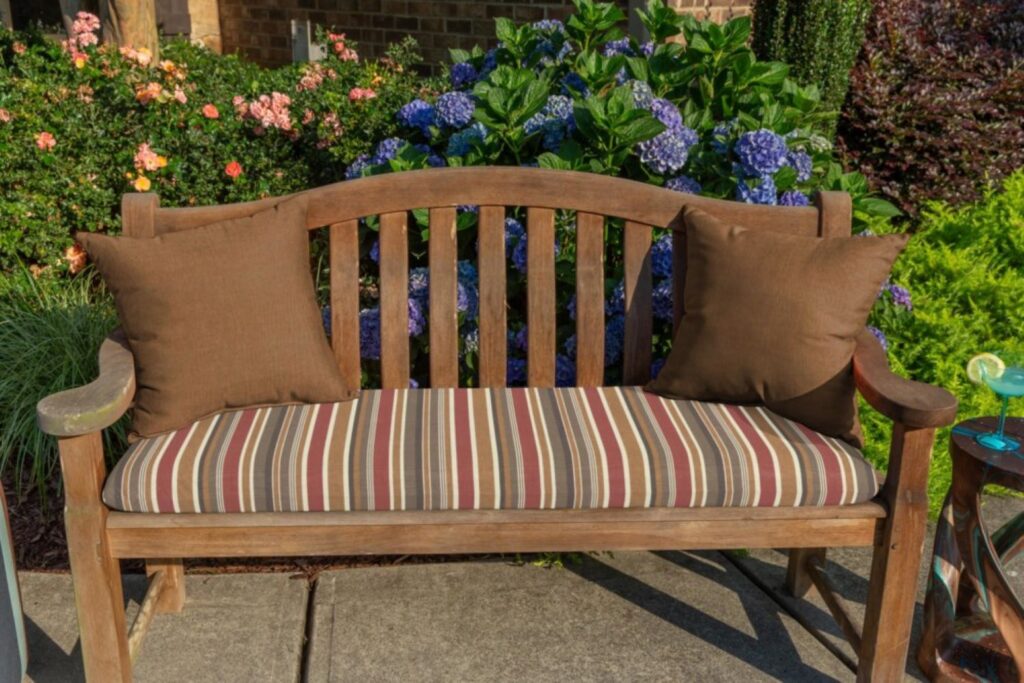When you are trying to figure out which fabric to select for your outdoor cushions, it can become downright confusing with the many options available on the market today. Because of that, all of us here at Cushion Connection wanted to simplify the selection process for you.
From Sunbrella to Abercrombie and Olefin, there is no shortage of fabric brands out there which is why we wanted to do an in-depth comparison between mega-fabric brands Sunbrella and Olefin to help you out.
Without further introduction, let’s get started.
Olefin Fabrics: Pros & Cons
Known to have soft-to-the-touch qualities that use environmentally-friendly materials, it’s no wonder why Olefin fabrics are shaking up the outdoor fabric world by storm. In addition to this, Olefin material is also known to be generally more affordable than Sunbrella and doesn’t produce static electricity as Sunbrella does.
But, we don’t want you to get the misconception that all is perfect with Olefin, Olefin fabrics do have their drawbacks.
In a post by SewingisCool, they say, “however, the melting factor of Olefin tends to make it the lesser of the two materials. This may be a concern if you live in regions of the country that get extremely hot.” This can serve as a major problem for those who are looking to use the fabric in extreme climates.
Also, Olefin does tend to fade with time while Sunbrella keeps true to its colors even over the years. So, if you are looking to get a vibrant yellow fabric, it may become not so bright after a few seasons — which isn’t desirable.
Here is a quick snapshot breakdown of both the pros and cons of Olefin fabrics.
Pros:
- Biodegradable materials
- Affordability
- Softness
Cons:
- Melts in extreme heat
- Not as durable
- Hard to clean
Next, let’s talk about the benefits and drawbacks of Sunbrella when it comes to outdoor usage.
Sunbrella Fabrics: Pros & Cons
Using high-end and fade-resistant acrylic, Sunbrella is known for its ability to withstand the test of time — and harsh weather elements! This includes places with extreme heat and extreme cold. (So, if you live in a location with tumultuous weather swings, this may be the perfect option for your patio!)
Also, Sunbrella outdoor materials can be used to resist water damage while being extremely easy to clean. While Olefin fabrics must be carefully spot-cleaned to give it that “fresh off the line” look.
As a drawback though, Sunbrella can be a pretty costly investment and may not be feasible to some if they are trying to take the more budget-friendly route. The fabric also has been known to produce static while the Olefin fabrics line does not.
Here is an overview look at both the pros and cons of Sunbrella fabrics.
Pros:
- Durability
- Weather and temperature-resistant
- Easy-to-care-for
Cons:
- High cost
- Not recyclable
- Produces static
So, which one is best for your patio needs? The answer is up to you, but we will give you our honest opinion.
Shop Sunbrella Fabrics at Cushion Connection
If you want our transparent thoughts about the two types of fabric, we will always be the cushion experts that will choose Sunbrella fabrics time and time again because of their durability and premium quality.
We do understand that Sunbrella may be pricier compared to Olefin fabrics, but the lastingness of Sunbrella is well worth the extra cost.
Are you looking to switch things up on your back deck? Consider your fabric choices! At Cushion Connection, we can customize any cushion you order and add Sunbrella fabric to your premium cushions. Check out our latest in fabrics today!


